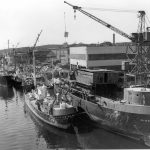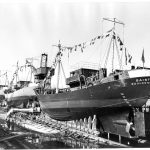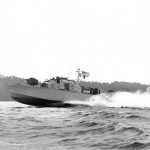As WWII ended, BIW faced a familiar situation, as a sudden surplus of military and commercial ships led to an inevitable plunge in shipbuilding orders. Although construction of many wartime destroyers continued to completion, contracts for two ships were suspended while partially complete, and several ships were cancelled entirely. Everyone was anxious to avoid a repeat of BIW’s bankruptcy after WWI, brought on by similar circumstances.
Fortunately BIW was able to find new work quickly, when the French government placed a large order for fishing trawlers to replace vessels lost in wartime. The contract was the largest BIW had ever received, worth more than $10 million, for the construction of six 240-foot trawlers, six 152-foot trawlers and 20 117-foot trawlers. The huge order led to some unusual construction practices, including building three trawlers bow-to-stern on the same shipways, launching all three at the same time.
Unfortunately for BIW, there were significant delays in receiving steel, engines, and winches for the trawlers. This lead to delays in construction, and incomplete trawlers were tied up along every bit of available waterfront space at BIW and elsewhere in Bath. The problems were eventually resolved and the trawlers were delivered throughout 1948 and 1949. As the trawlers left Maine and headed across the Atlantic, they were loaded with humanitarian relief supplies – often donated from the local area – for devastated French communities.
In the immediate postwar years there were a few contracts for experimental warships, as the Navy adapted to rapidly evolving technologies. Two incomplete wartime destroyers were sent to BIW for conversion to specialist submarine hunters, to counter an expected new generation of high-performance submarines. Another, the incomplete Timmerman, was built with an experimental high-pressure steam power plant, generating 100,000-horsepower in the same space as a conventional 60,000-horsepower plant. In a further effort to reduce weight and increase performance, Timmerman carried an experimental 1,000-volt electrical system, a new steering system, aluminum superstructure and many other innovations.
PT-810, another experimental vessel, was the first torpedo boat built at BIW since the early 20th century, and the last of the type constructed in Bath. The all-aluminum vessel was built indoors and ran sea trials on the Sheepscot River, achieving more than 47 knots. The final experiments of this era were the destroyer leaders Mitscher and John S. McCain, profiled in the May 2015 BIW NEWS.
While the trawlers and experimental vessels of this era could not maintain BIW at its wartime peak, they did keep the yard open, retain a skilled workforce and build familiarity with new technologies and equipment that would be seen in later ships.




